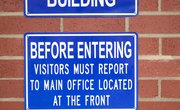Rumors and incidents of drugs, knives and guns being stored in lockers brings into question the age old practice of assigning hallroom lockers to students. In many schools across America, backpacks have taken the place of lockers. The days of struggling with stubborn lock combinations, balancing armloads of books and racing through hallways to beat the tardy bell to retrieve essential materials are virtually gone. However, recent health and security issues have raised alarm about backpacks also being used to hide contraband and weapons.
Backpack Conveniences
Backpacks help students stay organized by providing a portable receptacle for school essentials. They permit students to keep school supplies, books and personal items like cellphones and keys in one readily accessible location. Zippered pockets and pouches help students organize belongings and develop positive habits of neatness and order. With the number of students bringing laptops to school on the rise, backpacks also offer convenient storage for lightweight electronics.
Backpack Personalization
Students of all ages enjoy purchasing and customizing a backpack to express their sense of style and fashion. In addition to tapping creativity, backpacks can be covered with stickers that express a student's political views, favorite bands, sporting interests or hobbies. Unlike the inside of a decorated locker that is seldom seen by peers, the backpack goes virtually everywhere with the student. Friendships spring up when like-minded students start up a conversation and offer a compliment. Parents can persuade chidren to add strips of reflective tape to their backpack, which enhances student safety when walking to and from school if it is dark outside.
Muscle Strain
Despite their obvious appeal, backpacks pose some serious health concerns. Parents, medical experts and school administrators have raised questions about the long-term effects of backpack weight on developing bodies. Heavy contents can increase health risks for students by placing excessive strain on growing bones and muscles. Each year, thousands of students visit emergency rooms for treatment of backpack-related injuries, including muscle strains and spasms of the back and neck. Growing concerns have prompted some schools to initiate weigh-ins to determine whether backpack loads are excessive for students' stature. Health experts discourage carrying backpacks weighing more than 10 to 20 percent of the student's weight.
Safety Considerations
According to the American Academy of Pediatrics, following simple safety guidelines can help backpack wearers minimize health risks. Ensure that the backpack is properly designed and positioned. Look for backpacks with wide straps, and use both straps for even weight distribution of contents. Adjust strap length so that backpack sits properly on the shoulders rather than riding on the lower back. Wheeled backpacks also provide a safe alternative to traditional versions.
Security Issues
Increased concerns about school security have raised further questions about backpacks in many schools. To discourage the concealment of guns and contraband, some schools now require that backpacks be constructed of clear material that allows visibility of contents. Many schools have implemented policies permitting security guards to search backpacks. A few schools have gone so far as to prohibit backpacks, citing security concerns and spatial challenges posed by hefty backpacks cluttering crowded hallways and classrooms.
Related Articles
References
Writer Bio
Debra Charlton is a theater director and educator with expertise in Shakespearean production and performance. She holds a doctorate in theater history and criticism from the University of Texas at Austin. Charlton is the author of "Holistic Shakespeare: An Experiential Learning Approach," as well as numerous articles on theater, performance and pedagogy.










